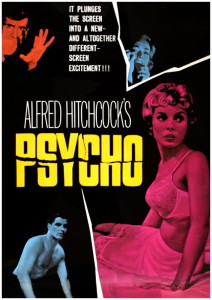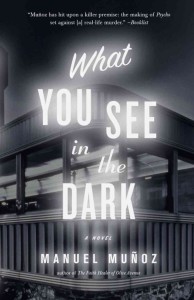There are a lot of interesting similarities between the novel “What You See in the Dark” and the film Psycho. In this blog post i will compare some of the characters from the novel with some of the characters form the film.
Teresa and Marion:
Both women seem to be the protagonist of the story at first, but their appearance is short. Teresa and Marion are both single women who live alone in their apartments. They both also have lovers (Teresa has Cheno and Marion has Sam) but they want more for their lives. When they both do seek to improve their lives they meet charming men (Dan Watson and Norman Bates) who contribute to their demise. Ultimately both women are murdered and their story pretty much ends there.
Dan Watson and Norman Bates:
Both are the son of a single mother who owns a motel. Dan and Norman are both portrayed as charming and good-looking young men. Both men also inspire the women to change their lives in some way. Dan inspires Teresa to begin singing at the cantina and Norman inspires Marion to return home and give back the money she has stolen. They both end up murdering women who they believe have acted immorally. Dan murders Teresa because he finds out about Cheno and Norman murders Marion after he feels that she is trying to seduce him.
Arlene and Norman’s Mother(or Norman acting as his mother):
Both women are single mothers who have lost their husbands (Arlene’s abandoned her while Norman’s father died). They are also both portrayed as heavily influencing their sons and being very protective of them. Arlene worries when Dan begins to date Teresa and advises him to never bring her to the diner when she is there. Norman’s mother is critical of any female presence in his life and immediately seeks to eliminate them.
Cheno and Sam:
Both of these men are the lovers of Teresa and Marion. They both inspire the women to make a drastic change in their lives. Cheno convinces Teresa to sing, while Sam unknowingly causes Marion to steal money and start a new life with him.
Candy and The detective (Mr. Arbogast):
Both of these characters are on the outside looking in. They both investigate the lives of the victims and ultimately know intimate information that nobody else knows.
These are all of the similarities that I could come up with. If you were able to find anymore interesting similarities comment below!



I agree that many characters from What You See in the Dark and Psycho are very similar. I would also say that another similarity between Dan Watson and Norman Bates are their looks. They both seem very charming and sweet. Dan Watson has all the girls in town talking about him and they Candy, the girl she works with at the shoe store, is jealous of her when she sees that Teresa is going to have lunch with Dan. Also, Arlene has to put up with all the girls at the diner staring and gossiping about her son Dan because they are attracted to him. Similar to Norman Bates, who seems to be very sweet bringing Marion sandwiches and giving her suite number one so if she needs anything he’ll be closer to her. Norman also seems to be a delicate character having a solitary hobby such as stuffing birds and living in an isolated part of town.
That being said, both Dan Watson and Norman Bates have the incredible ability of deceiving people around them their dual personality. No one suspects that they would be capable of such a gruesome crime and be able to plot their way out of their action to deceive the law. Both of these men used their mothers, in one way or another, to get them out of a crime they committed.
This is a thoughtful analysis of both works. I did see the same similarities between the two especially as you mentioned between Marion and Teresa. They were both about to embark in a new chapter before they were murdered by men they initially trusted and who seemed inoffensive. I think it is interesting that both murders have a sexual component: Dan killed Teresa, we are told, inspired by his jealousy and Norman murders women, his mother and our protagonist, because he cannot properly deal with the idea of a woman being an autonomous being with her own emotional life and also because he wants to oppress the feelings beautiful women arouse in him.
The only thing that troubles me about Munoz’s book is that we never have a reliable explanation of the fact surrounding the murder, and most importantly, Dan’s reasoning behind it. What drove this handsome bachelor to commit a crime based on a suspicion of betrayal? With Norman we have a way to understand his actions. Although they are still despicable, at least we know how he justifies them. But Arlene seems a nice mother and Dan has a satisfying life, at least on the surface,so it is difficult to accept that he suddenly became a murderer. I think his actions have something to do with his family history because when he came over to his mother house before he left town, Arlene kept on referencing his brother and his problems with alcoholism and violence.
I agree that the characters do share similarities with those of Psycho, but I also think that it goes past the characters and also shares certain similar scenes. For example, in the film, Marion is seen by her boss driving in her car as he crosses the street, but in the book, Teresa sees the actress crossing the street in front of her. I think this serves as what people have mentioned before about someone looking in from the outside. It’s also interesting to see the woman that will be murdered see the woman who will play a woman that will be murdered. The scene where Dan is talking to Teresa for the first time outside of the bar, invites her in to where he works, makes her sandwiches, and talks about singing for him shares an uncanny resemblance to when Norman meets Marion and Norman makes sandwiches for her. The significance of these similarities is great because it serves to create an even more realistic and in-depth experience to the reader (if the reader has watched Psycho, of course).
On a side note, I also think having watched Psycho prior to reading the book definitely gave us a better understanding of the book.
The film Psycho, directed by Alfred Hitchcock serves as a foundation and a backbone to the novel, What you see in the Dark, written by Manuel Muñoz. Substantially, both the novel and the film parallel in many manners. For example, in Part One of the book, Manuel Muñoz opens the novel as he depicts Dan Watson. He states, ‘”he was the most handsome man in town for sure, and his mother owned a little motel out in the highway. He always seemed to be wearing only brand-new shirts: no one could keep shirts that color, that softness, time after time, hanging them to dry stiff on a backyard line… He would be a good man to marry.“ Likewise, Norman Bates is quite congruent to the character of Dan Watson. In the film, Norman Bate, who is also the son of a motel owner, and is depicted as a witty, attractive, handsome, tall, white male.
Although Psycho, and What You See in the Dark, parallel in many aspects, the Goth theme of darkness seems to be neglected and undiscovered. There are many dark themes that live throughout the novel. For example, the existence of darkness that lies throughout the movie theater, the darkness that subsides on the driveway in front of Arlene’s house, the swing sets that is surrounded by the dark wood, and the dark fatal stairways that lead to the apartments.
In a similar illustration, the film Psycho has many gory, gothic and dark themes. However, the lack of color that the film portrays substantially stands as a major theme of darkness.
The film Psycho, was premiered in the 1960. With obvious intentions, the director Alfred Hitchcock compels the viewers with a black and white film. Although black and white may not seem dark at first, a interesting fact that should be know is that by the 1960, much of television was being viewed in color. Therefore, the lack of color portrays and serves as a theme of darkness.